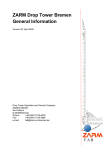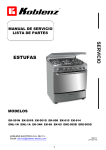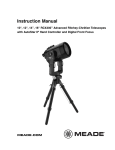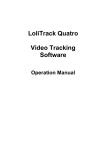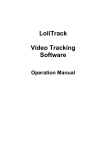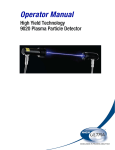Download Meade RCX400 User manual
Transcript
A few advices on the use of amateur telescopes Meade RCX400 V. Kornilov, B. Safonov May 12, 2010 Introduction It is known that small 25 – 30 cm amateur class telescopes are used in solving many problems of astronomy: study of variable stars, search for exoplanets, registration of optic tramsients and gammaray bursts. Very often these instruments are used in site testing campaignes. To study the optical turbulence above planned location of the 2.5 m telescope of the SAI, 30 cm telescope Meade RCX400 was purchased. This telescope is progressive representative of the its class. Here we would like to present some tips on how to force such a telescope to operate in automatic mode over long time. May be some tips are related to the specifics of this telescope, others are more general and can be applied in different situations. We operate a telescope at 2100 m above sea level with temperatures of down to −20◦ C and with humidity reaching to 100% over 2 years almost every clear night. Despite recurring problems with this telescope, about 2000 hours of measurements of the optical turbulence were carried out during which more than 3000 pointing were made. We will not describe the features of the telescope, they can be found in the user manual and on different sites. We emphasize only that the developers tried to make a convenient instrument for occasional observations. A telescope for automatic operation (without operational intervention, with only periodic remote control) set for a long time and is constantly under the control of external machine. Naturally, many of the inherent features (such as a GPS receiver) seem superfluous, and, conversely, some of the functionality you need is absent. However, we are not going to criticize the shortcomings of the telescope and try to describe our experience in overcoming them. 1 Telescope installation and additional arrangements Fork mount of the telescope allows you to use it in the polar or alt-azimuth installation. If the possibility exists set the telescope in the equatorial configuration. Thus, you will greatly simplify task of monitoring the behavior of the instrument. Do not rely on the fact that the software will correct errors of the mount alignment. Align position of the polar axis with the greatest possible care. The disadvantage of the polar set is some loss of stiffness due to the equatorial wedge under the mount base. However, if it is stationary robust construction, its influence will be much less than a vibration of the mount. 1 If the size of telescope enclosure permits the use of the alt-azimuth configuration only, install carefully azimuthal axis to vertical. You can use striding level. Our instrument is placed in the altazimuth configuration, inside the enclosure of the size of 1.5 by 1.5 meters with a roof of cabriolet-type made of thick fabric. In Fig. 1 (left) one can clearly see that we are using only part of the regular tripod. Figure 1: Telescope Meade RCX400 under the dome of automatic site testing monitor of SAI. Left: July 2007, right: March 2008 No matter how successful the situation is, it will be impossible to avoid some problems. Therefore, we should consider carefully controls and methods of elimination of abnormal situations. Of course, we are not talking about emergency cases, the failure of components of the telescope, but the frequent cases of software failures and their consequences. Improperly laid cables from the receiving equipment can also cause problems, so they should all be brought together in one bundle of sufficient length. It’s most convenient to tie cables and wires to plait by plastic ties, but their tails can cling to other objects. Hence that part of the bundle which will move one way or another during rotation the telescope have to be fasten by bonding tape or rings of the shrink tube. In some cases, it’s necessary to remotely power on/off the telescope. You can use either the purchased TCP/IP switch, but we chose to make a special converter +24/+12 V (main power supply of ASM is 24 Volts from two batteries in series) controlled by the same serial line RS232 which used for telescope control. For software homogeneity, this unit switch the power by on and off commands :oN# and :oF#. Other commands are passed on to the telescope. General WEB-camera acquire a reputation for remote monitoring and resolution of emergency. The camera installed in such a way that one can see the bigger part of the telescope. We used quite sensitive WEB-camera Philips SPC900NC. The camera allows to see the telescope at night in the moonlight. Additionally you can install bright remotely controlled LEDs. Such illumination is sufficient to get a general idea of what is happening under the dome. 2 Figure 2: Visual inspection of the telescope with help of WEB-camera Philips SPC900NC. Left: during the observations in the moonlight, right: in the dome closed and the backlight turned on. Green LED indicates that dome is closed Another problem was discovered for 2 - 3 months after the installation of the telescope. These were an insects, which with the approach of autumn begun to hide in the notches, particularly in the gap between the corrector plate and telescope tube. We had to set a special cuff of soft tissue covering the internal volume of the telescope tube to protect the telescope from this phenomen. The measure was sufficiently effective, the need to clean the mirrors didn’t occur anymore. If your task permits, limit the maximum speed of the telescope axis to a reasonable value, for example: 3◦ /s. This will prevent the breakdown of the DC motor in case of difficulty of the telescope movement (e.g., at low temperatures). 2 Telescope finder Do not rely on that the nominal alignment of coordinate system Auto Alignment made on stars will serve a long time. No more than a few nights. It’s problematic to execute it remotely without the additional equipment. Therefore throw away the standard holder of the finder and replace it with a reliable, robust holder. On the finder install the CCD camera instead of the eyepiece. The same camera Philips SPC900NC is suitable for this. The field of view will be sufficient: in the case of standard RCX400 finder — 0.9◦ × 1.2◦ . It is advisable to mount the camera in a sealed metal housing. How to remove the original packing one can found on the site ( tt http://www.robertreeves.com/900NC.htm). You can see the stars up to 7m ÷ 8m using the maximal exposure . In Fig. 3 the image of the Pleiades, obtained with 5 frames per second and the automatic gain control (gain=auto) is shown. The finder design allows you to focus the camera by rotating the objective on the thread. After focusing the lens should be secured firmly to prevent its spontaneous shifts, otherwise the optical axis of the finder and telescope will diverge with time significantly (a few arcmin). 3 Figure 3: The Pleiades image obtained with the camera finder. The faintest star in the frame has a magnitude 8.3m 3 The maintenance of the telescope coordinate system The main task of the telescope mount is pointing and tracking of the object being studied. In principle, the Meade RCX400 fork mount and its electronics execute that task, but the beginning of work is a weak point. Applied for the orientation of the mount level and magnetometer are good for visiting amateur sessions, but in a stationary telescope installation is rather pointless. Setting the coordinate system by pointing the telescope at 2-3 brightest star (Auto Alignment) provides good accuracy but only for a few nights, because of the problem of saving of the accuracy from a shutdown to a shutdown. Of course, you can keep the power on all the time, but even if we ignore the energy saving, it does not solve the problem completely. Typically, for a few nights a coordinate system is lost due to failures and mistakes in the proprietary software. Over 2 years of observations, we have consistently examined several options for the conservation and restoration of the coordinate system. In the following list these regimes of completion / start of the telescope are specified: 1. Park position. The Meade telescope parking using command :hP# has the following disadvantages: 1) there is no possibility to obtain information on the completion of this procedure, 2) a common error in the telescope soft often leads to tripping-over a limiter and to loss of coordinate system, when telescope moving in a horizontal coordinate system. 2. Sleep Mode. This feature allows to reduce power consumption to a minimum without turning off the telescope. The regime is activated by a command :hN# and the normal functioning is switched in :hW#. However, several times we observed, when being in sleep mode, the telescope would suddenly begin to move with big speed and ran into the limit stop. 3. Home Position. After telescope start, the command :hF# is issued — search starting position. The telescope is positioned on its sensors, which gives sufficient accuracy for next pointing with the use of finder. Disadvantages are a longer duration of the procedure and the low reliability of the level. 4 4. Default Position. In this mode, before each shutdown the telescope is set at a fixed position which coordinates are pre-installed with the command :hS# as default. Thus, when you turn the telescope on, it already has the correct horizontal coordinate system. To work in the equatorial system the exact time is needed. The disadvantages are obvious: turning off the telescope in the wrong position or a random shifting in the off state lead to loss of orientation. The Home Position is the only method that ensures the recovery of the coordinate system, although its accuracy is not high. Another advantage of this method is its autonomy, it doesn’t require periodic inspection of the telescope and remote manipulation. Therefore, this method was used for 1.5 years as basic. However, after the failure of the level sensor (due to movements in altitude the cable connecting the level/magnetometer board with the main board was broken), we had to look for an alternative method of orientation recovery. It turned out that the telescope can be set to the desired starting position with an accuracy of better than 20 − 30′ manually (by offset commands) relying on image from the dome camera. Then the telescope shutdowns. After subsequent start, the coordinate system will be consistent with the telescope position. This procedure is so simple and reliable, that we use it for the last few months. Refinement of the coordinate system is called each time after a successful pointing on the measured stars with help of the sync command :CA#. When work finished, the telescope is installed in the more accurate starting position. Another useful tool is a laser pointer, fixed on the telescope tube and indicating the right initial position with help of label placed on the enclosure wall. Positioning accuracy is better than 10′ . Also the return telescope to working position manually becomes simplier. In principle, having the camera finder and using undocumented commands :EK...# (See next section), one can perform the procedure Auto Alignment but we did not test this possibility. 4 Focusing and collimating In principle the design of the focusing mechanism of telescope is a very progressive and flexible. However, the real implementation leads to the fact that in the process of refocusing telescope optical system is gradually coming to unadjusted state: the corrector plate (with the secondary mirror fixed on it) become tilted. So-called secondary coma is appeared persistent throughout the field of view. In addition the optical axes of the instrument and the finder diverge. Extra focal image is not kept as axisymmetric. Since the DIMM device uses two off-axis entrance aperture, this coma is seen as astigmatism in both images. Established electronics allows to collimate the telescope, i.e. to tilt the corrector plate in two directions in such a way that the optical axes of the mirrors coincide. This procedure requires the presence of an observer and it is not trivial task to execute it remotely even if you can see the image in the field of view. However, if you use a single device as detector, you should inspect extra focal image without violating working focus position. De-focusing of the image can be reached either by de-focusing viewer, or by displacement of CCD camera. You must then carry out a thorough adjustment (collimation) and remember it by the command “Collimation/Set Default” of AutostarII menu. Then the restoration of the optimal collimation in optimal focusing position may be done with command “Collimation/Restore Default”. To remotely call the execution of the menu item “Collimation/Restore Default”, not having the appropriate command in the list of remote commands, you can use an undocumented command 5 :EK...# simulating the pushing of the buttons on the telescope keypad. The buttons codes are given in Appendix A. Assuming that pad is in initial state after power on, the sequence of the commands to do correct collimation restoration is listed in the table. It reflects a navigation on AutostarII menu. Table 1: The sequence of the commands to call “Collimation/Restore Default” 1 2 3 4 5 6 7 Command Button :EK09# :EK09# :EK09# :EK13# :EK68# :EK68# :EK68# Mode Mode Mode Enter Scroll down Scroll down Scroll down 8 9 10 11 12 13 14 Command Button :EK68# :EK68# :EK13# :EK68# :EK13# :EK68# :EK13# Scroll Scroll Enter Scroll Enter Scroll Enter down down down down Note that it is necessary to wait for the answer to each command, i.e. pause between two commands must be at least 2 s, and starting after the last command the recovery procedure takes not less than 1.5 min. Telescope keypad may be disconnected. 5 Dew cap All catadioptric telescopes have a weak spot: the corrector plate is located at the top of tube and therefore is affected by fogging due to radiative cooling under clear skies. At high ground humidity, which is often observed at the site of the installation of our telescope in the off-season, this problem leads to the loss of a perceptible part of the observation time. The design of the telescope provides a heater of corrector plate, but its efficiency is very low, since the power of the heating element is small and it is located just on the edge of corrector plate, which has poor thermal conductivity. Having considered the various ways to mitigate of fogging, we stopped at the classic passive dew cap. However, since the space under telescope enclosure is small, we modified its structure. Because the combined instrument MASS/DIMM requires not all entrance aperture but only three sections with a diameter of about 10 cm, our dew cap consists of a metal cap, put on the front edge of the telescope tube with three octagonal tubes diameter of 10 – 11 cm and a length 15 cm The location of these holes and tubes selected in accordance with the MASS/DIMM input apertures geometry. After installing such dew cap in November 2007, the fogging problem was virtually solved. This kind of blind (see Fig. 1 is somewhat inconvenient for the adjustment of the instrument and the telescope, so it should be easily removed and installed again. 6 6 Appendix A Table 2: Command :EK. . . # codes, corresponding the keypad of Autostar II (The code in decimal form, movement arrows codes could not be determined Code 09 13 49 50 51 52 53 54 55 56 Button MODE ENTER Speed (1) Cald (2) M (3) Focus (4) SS (5) Star (6) Ret (7) IC (8) Symbol LF CR 1 2 3 4 5 6 7 8 Code 57 63 68 71 72 85 ?? ?? ?? ?? 7 Button NGC (9) Help Scroll down ▽ Go To (press) Go To (release) Scroll up △ Arrow ⇑ Arrow ⇓ Arrow ⇐ Arrow ⇒ Symbol 9 ? D G H U – – – – Figure 4: Main dimensions of Meade RCX400 12′′ telescope, needed for enclosure design and installation 8








